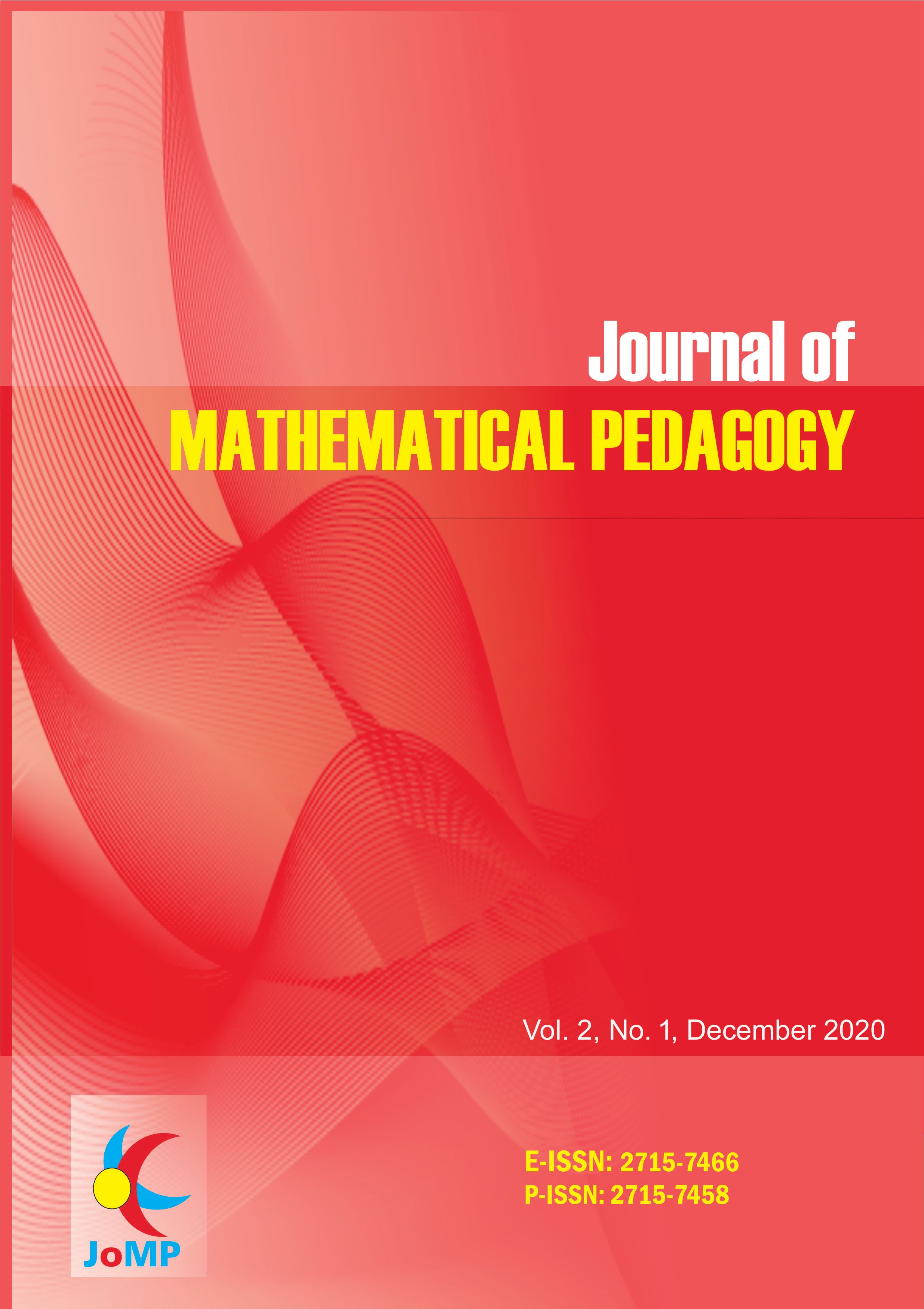Analysis of Google Classroom's Online Learning Motivation on Mathematics Subjects
DOI:
https://doi.org/10.26740/jomp.v2n1.p18-25Keywords:
Online learning, Google Classroom, MotivationAbstract
This article aims to describe students' motivation for online learning using Google Classroom in mathematics. In this study, the method used is descriptive qualitative, involving 21 senior high school students in Sukoharjo. The data collection techniques used were questionnaires and interviews. The results showed that the motivation to learn online Google Classroom in mathematics is influenced by internal and external factors. The first internal factor, namely the desire and desire above 60% indicates a good category, supported by the results of interviews that students have the desire and desire to succeed after using learning using Google Classroom. Second, there is an encouragement and learning need above 70% in a good category, indicating that students are motivated to learn. With the interview results, students answered that the ease of using Google Classroom provided a special experience in the student learning process that gave rise to a desire and encouragement to learn. The external factor, namely the existence of interesting activities in learning Google Classroom, is considered quite effective. From the four statements given, it reaches an average of 65%, the category is sufficient which indicates that Google Classroom can be accepted by students
Keywords: Online learning, Google Classroom, Motivation
References
Arizona, K., Abidin, Z., & Rumansyah, R. (2020). Pembelajaran online berbasis proyek salah satu solusi kegiatan belajar mengajar di tengah pandemi covid-19. Jurnal Ilmiah Profesi pendidikan, 5(1), 64-70.
Ary, D., Jacobs, L. C., Irvine, C. K. S., & Walker, D. (2018). Introduction to research in education. Cengage Learning.
Ciampa, K. (2014). Learning in a mobile age: an investigation of student motivation. Journal of Computer Assisted Learning, 30(1), 82-96.
Crawford, J., Butler-Henderson, K., Rudolph, J., Malkawi, B., Glowatz, M., Burton, R., ... & Lam, S. (2020). COVID-19: 20 countries' higher education intra-period digital pedagogy responses. Journal of Applied Learning & Teaching, 3(1), 1-20
Creswell, J. W., & Poth, C. N. (2016). Qualitative inquiry and research design: Choosing among five approaches. Sage publications.
Creswell, J. W., & Creswell, J. D. (2017). Research design: Qualitative, quantitative, and mixed methods approaches. Sage publications.
Dewi, W. A. F. (2020). Dampak Covid-19 terhadap implementasi pembelajaran daring di Sekolah Dasar. Edukatif: Jurnal Ilmu Pendidikan, 2(1), 55-61.
Hakim, A. B (2016). Efektifitas Penggunaan E-Learning Moodle, Google Classroom Dan Edmodo. I-Statement, 2 (1), 2-6.
Hasbi, M., Lukito, A., Sulaiman, R., & Muzaini, M. (2019). Improving the Mathematical Connection Ability of Middle-School Students through Realistic Mathematics Approach. Journal of Mathematical Pedagogy (JoMP), 1(1), 37-46.
Hill, H. C., & Ball, D. L. (2004). Learning mathematics for teaching: Results from California's mathematics professional development institutes. Journal for research in mathematics education, 330-351.
Hudojo, H. (1988). Mengajar belajar matematika. Jakarta: Depdikbud.
Isman, M. (2016). Pembelajaran Moda Dalam Jaringan (Moda Daring). ISBN: 978-602-361-045-7.
Kompri, (2016). Motivasi Pembelajaran Prespektif Guru dan Siswa. Bandung: PT. Rosda Karya.
Kumar, J. A., Bervell, B., & Osman, S. (2020). Google classroom: insights from Malaysian higher education students and instructors experiences. Education and information technologies, 25(5), 4175-4195.
Marinoni, G., Vant Land, H., & Jensen, T. (2020). The impact of Covid-19 on higher education around the world. IAU Global Survey Report.
Moleong, L. J. (2018). Metodologi Penelitian Kualitatif. Bandung: PT Rosdakarya.
National Council of Teachers of Mathematics (NCTM). (2000). Principles And Standards Schools Mathematics. Reston, VA:NCTM.
Niess, M. L. (2005). Preparing teachers to teach science and mathematics with technology: Developing a technology pedagogical content knowledge. Teaching and teacher education, 21(5), 509-523.
Norman, G. (2010). Likert scales, levels of measurement and the œlaws of statistics. Advances in health sciences education, 15(5), 625-632.
Oyarinde, O. N., & Komolafe, O. G. (2020). Impact of Google Classroom as an Online Learning Delivery during COVID-19 Pandemic: The Case of a Secondary School in Nigeria. Journal of Education, Society and Behavioural Science, 53-61.
Pratama, D., & Sopryadi, H. (2016). Analisis Pengaruh Pemanfaatan Google Classroom terhadap Efisiensi pada STMIK XYZ. In Seminar Nasional Teknologi Informasi.
Purwanto, A., Pramono, R., Asbari, M., Hyun, C., Wijayanti, L., Putri, R., & santoso, priyono. (2020). Studi Eksploratif Dampak Pandemi COVID-19 Terhadap Proses Pembelajaran Online di Sekolah Dasar. EduPsyCouns: Journal of Education, Psychology and Counseling, 2(1), 1-12.
Sardiman, A. M. (2018). Interaksi dan Motivasi Belajar Mengajar (cetakan 24). Jakarta: Rajawali Pers.
Schulze, S., & van Heeren, M. (2015). Learning environments matter: Identifying influences on the motivation to learn science. South African Journal of Education, 35(2), 1058.
Skemp, R. R. (1987). The psychology of learning mathematics. Psychology Press.
Sobron, A. N., Bayu, B., Rani, R., & Meidawati, M. (2019, October). Pengaruh Daring Learning terhadap Hasil Belajar IPA Siswa Sekolah Dasar. In Seminar Nasional Sains & Entrepreneurship (Vol. 1, No. 1).
Soedjadi, R. (2000). Kiat pendidikan matematika di Indonesia: konstatasi keadaan masa kini menuju harapan masa depan. Direktorat Jenderal Pendidikan Tinggi, Departemen Pendidikan Nasional.
Sugiyono (2018). Metode Penelitian Kuantitatif, Kualitatif dan R&D. Bandung: CV Alfabeta.
TaÅŸar, M. F. (2010). What part of the concept of acceleration is difficult to understand: the mathematics, the physics, or both?. ZDM, 42(5), 469-482
Taylor, S. J., Bogdan, R., & DeVault, M. (2015). Introduction to qualitative research methods: A guidebook and resource. John Wiley & Sons.
Van Den Heuvel-Panhuizen, M. (2003). The didactical use of models in realistic mathematics education: An example from a longitudinal trajectory on percentage. Educational studies in Mathematics, 54(1), 9-35
Windhiyana, E. (2020). Dampak Covid-19 terhadap kegiatan pembelajaran online di sebuah perguruan tinggi kristen di Indonesia. Perspektif Ilmu Pendidikan, 34(1), 1-8.
 Abstract views: 657
,
Abstract views: 657
, PDF Downloads: 375
PDF Downloads: 375





